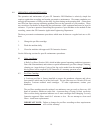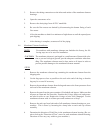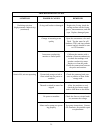
7. Inspect the membrane element housing and clean as necessary to remove any con-
taminants, obstructions, etc.
8. Apply a small amount of O-ring lubricant to all O-rings on the end caps, and the
brine seal on the membrane element.
9. Insert the downstream end of the membrane element in the upstream end of the
membrane element housing (i.e., load in the direction of flow; the brine seal is on
the end of the membrane element that goes in last. For membrane element hous-
ings with the flow arrow pointing up refer to Step 10.
10. Insert the membrane element in the membrane element housing with a smooth and
constant motion. When you reach the point where the brine seal is about to enter
the housing, gently turn the membrane element to ensure the brine seal enters the
housing without coming out of the brine seal groove.
11. When all of your membrane elements are installed, you must close the membrane
element housing by reinstalling the end caps and clamps. It is preferred to install
the bottom end cap first, and tighten the clamp completely, before installing the
top end cap.
12. Reinstall the end caps by gently twisting the end cap while pushing it on to the
permeate tube. Ensure that you do not pinch or fatigue any O-rings while pushing
the end cap on. Push the end cap on until the outer diameter of the cap is flush with
the outer diameter of the membrane element housing. Install the clamp halves, and
tighten the bolts until the clamp halves meet.
13. Reconnect any fittings that were removed when disassembling the membrane ele-
ment housings.
14. Return to Section 3.2 (Start-Up, Step 1).
4.7 Membrane Element Replacement
As time progresses, the efficiency of the membrane element will be reduced. In general,
the salt rejection does not change much until two-three years after installation, when oper-
ated on properly pretreated feed water and when routine maintenance is performed. The
permeate flow rate will begin to decline slightly after one year of operation but can be
extended with diligent flushing and cleaning of the machine. High pH feed water and/or
precipitation of hardness can cause premature loss in rejection and even flow rate. The fol-
lowing procedure is to be followed to replace existing membrane elements in the machine.
STEPS
1. Remove the end caps and clamps from all of the membrane element housings.
23


















